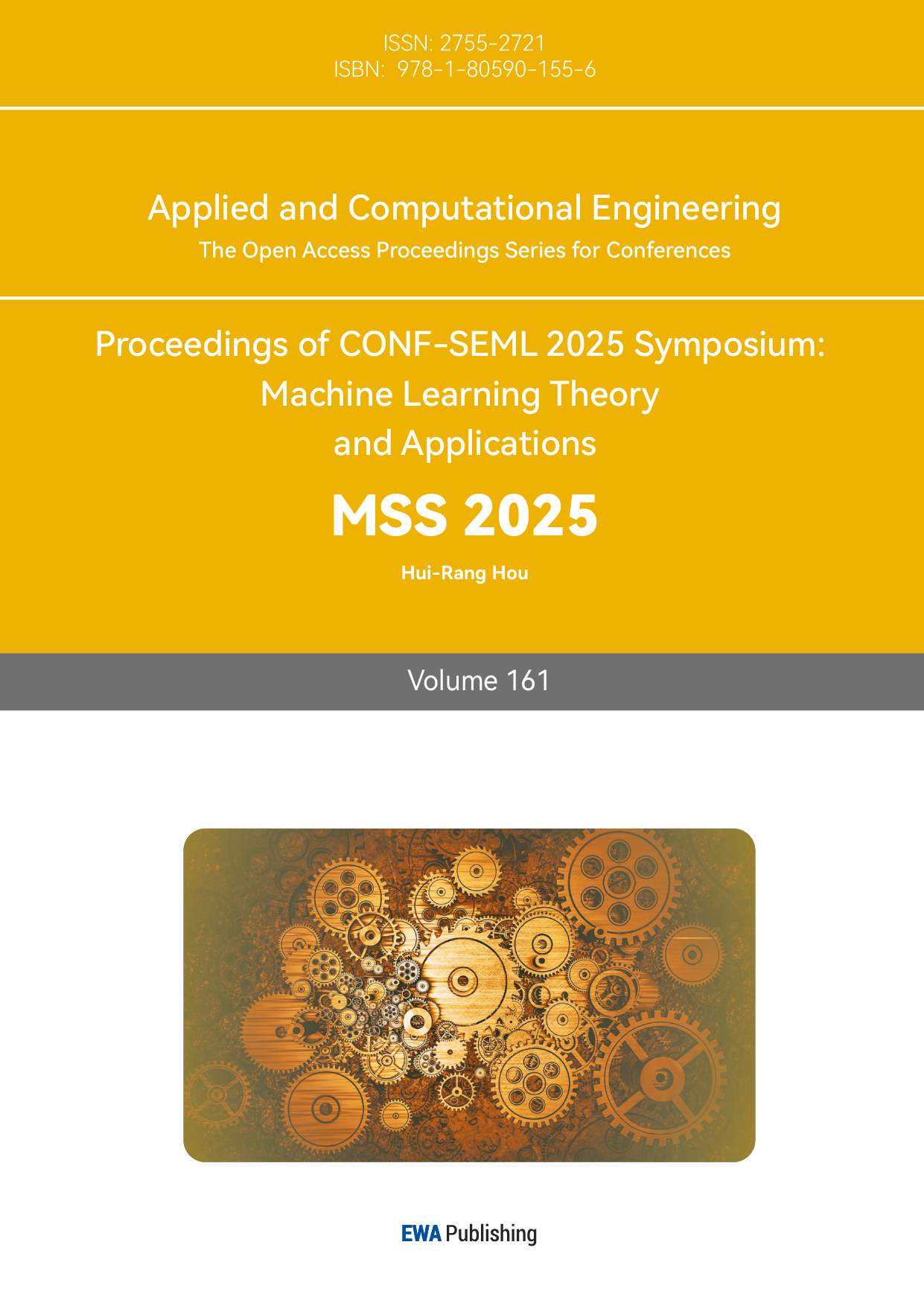References
[1]. Wang, Z.K., et al. (2019) A review of underwater robot propulsion system. Pearl River Water Transport, 14: 84-85.
[2]. Du, X.Q. (2021) Research on propulsion performance and posture tracking control of UPR-UPU-UR vector propulsion mechanism. Shandong University.
[3]. Zhang, J.W., et al. (2021) Application status and development trend of underwater propulsion. Ship Engineering, 43(06): 61-65+78.
[4]. Zhang, R. Shen, Z. and Wang, Z. (2018) Ostraciiform Underwater Robot With Segmented Caudal Fin. IEEE Robotics and Automation Letters, 3(4): 2902-2909.
[5]. Jin, L., Liang, H. and Yang, C. (2021) Sonar image recognition of underwater target based on convolutional neural network. Journal of Northwestern Polytechnical University, 39(2): 285-291.
[6]. Sun, Z. and Lv, Y. (2022) Underwater attached organisms intelligent detection based on an enhanced YOLO. 2022 IEEE International Conference on Electrical Engineering, Big Data and Algorithms (EEBDA). IEEE, 1118-1122.
[7]. Ji, D., et al. (2021) Model-free fault diagnosis for autonomous underwater vehicles using sequence convolutional neural network. Ocean Engineering,, 232: 108874.
[8]. Zhang, Z., et al. (2023) Fatigue‐resistant conducting polymer hydrogels as strain sensor for underwater robotics. Advanced Functional Materials, 33(42): 2305705.
[9]. Zhang, H. and Guo, Z. (2023) Recent advances in self-healing superhydrophobic coatings. Nano Today, 51.
[10]. Hou, Y.K., et al. (2023) Robust adaptive finite-time tracking control for Intervention-AUV with input saturation and output constraints using high-order control barrier function. Ocean Engineering, 268: 113219.
[11]. Zhang, Y.Q. (2024) Research on anti-water flow trajectory tracking control based on meta-learning and adaptation. Jilin University.
[12]. Aldhaheri, S., et al. (2022) Underwater robot manipulation: Advances, challenges and prospective ventures. Oceans 2022-Chennai. IEEE, 1-7.
[13]. Xu, J.Q. (2021) Overview of the technology of permanent magnet propulsion system for underwater robots. Robot Industry, 04: 58-63.
[14]. Cai, W., et al. (2023) Cooperative Artificial Intelligence for underwater robotic swarm. Robotics and Autonomous Systems, 164: 104410.
Cite this article
Chen,G. (2025). The Design and Optimization Technology of Propulsion Systems for Operative Underwater Robots. Applied and Computational Engineering,161,17-23.
Data availability
The datasets used and/or analyzed during the current study will be available from the authors upon reasonable request.
Disclaimer/Publisher's Note
The statements, opinions and data contained in all publications are solely those of the individual author(s) and contributor(s) and not of EWA Publishing and/or the editor(s). EWA Publishing and/or the editor(s) disclaim responsibility for any injury to people or property resulting from any ideas, methods, instructions or products referred to in the content.
About volume
Volume title: Proceedings of CONF-MSS 2025 Symposium: Automation and Smart Technologies in Petroleum Engineering
© 2024 by the author(s). Licensee EWA Publishing, Oxford, UK. This article is an open access article distributed under the terms and
conditions of the Creative Commons Attribution (CC BY) license. Authors who
publish this series agree to the following terms:
1. Authors retain copyright and grant the series right of first publication with the work simultaneously licensed under a Creative Commons
Attribution License that allows others to share the work with an acknowledgment of the work's authorship and initial publication in this
series.
2. Authors are able to enter into separate, additional contractual arrangements for the non-exclusive distribution of the series's published
version of the work (e.g., post it to an institutional repository or publish it in a book), with an acknowledgment of its initial
publication in this series.
3. Authors are permitted and encouraged to post their work online (e.g., in institutional repositories or on their website) prior to and
during the submission process, as it can lead to productive exchanges, as well as earlier and greater citation of published work (See
Open access policy for details).
References
[1]. Wang, Z.K., et al. (2019) A review of underwater robot propulsion system. Pearl River Water Transport, 14: 84-85.
[2]. Du, X.Q. (2021) Research on propulsion performance and posture tracking control of UPR-UPU-UR vector propulsion mechanism. Shandong University.
[3]. Zhang, J.W., et al. (2021) Application status and development trend of underwater propulsion. Ship Engineering, 43(06): 61-65+78.
[4]. Zhang, R. Shen, Z. and Wang, Z. (2018) Ostraciiform Underwater Robot With Segmented Caudal Fin. IEEE Robotics and Automation Letters, 3(4): 2902-2909.
[5]. Jin, L., Liang, H. and Yang, C. (2021) Sonar image recognition of underwater target based on convolutional neural network. Journal of Northwestern Polytechnical University, 39(2): 285-291.
[6]. Sun, Z. and Lv, Y. (2022) Underwater attached organisms intelligent detection based on an enhanced YOLO. 2022 IEEE International Conference on Electrical Engineering, Big Data and Algorithms (EEBDA). IEEE, 1118-1122.
[7]. Ji, D., et al. (2021) Model-free fault diagnosis for autonomous underwater vehicles using sequence convolutional neural network. Ocean Engineering,, 232: 108874.
[8]. Zhang, Z., et al. (2023) Fatigue‐resistant conducting polymer hydrogels as strain sensor for underwater robotics. Advanced Functional Materials, 33(42): 2305705.
[9]. Zhang, H. and Guo, Z. (2023) Recent advances in self-healing superhydrophobic coatings. Nano Today, 51.
[10]. Hou, Y.K., et al. (2023) Robust adaptive finite-time tracking control for Intervention-AUV with input saturation and output constraints using high-order control barrier function. Ocean Engineering, 268: 113219.
[11]. Zhang, Y.Q. (2024) Research on anti-water flow trajectory tracking control based on meta-learning and adaptation. Jilin University.
[12]. Aldhaheri, S., et al. (2022) Underwater robot manipulation: Advances, challenges and prospective ventures. Oceans 2022-Chennai. IEEE, 1-7.
[13]. Xu, J.Q. (2021) Overview of the technology of permanent magnet propulsion system for underwater robots. Robot Industry, 04: 58-63.
[14]. Cai, W., et al. (2023) Cooperative Artificial Intelligence for underwater robotic swarm. Robotics and Autonomous Systems, 164: 104410.









